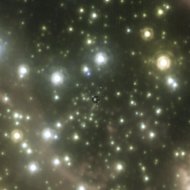 Scientists have found the biggest black holes known to exist -- each one 10 billion times the size of our sun. A team led by astronomers at the University of California, Berkeley, discovered the two gigantic black holes in clusters of elliptical galaxies more than 300 million light years away. That's relatively close on the galactic scale.
Scientists have found the biggest black holes known to exist -- each one 10 billion times the size of our sun. A team led by astronomers at the University of California, Berkeley, discovered the two gigantic black holes in clusters of elliptical galaxies more than 300 million light years away. That's relatively close on the galactic scale.
"They are monstrous," Berkeley astrophysicist Chung-Pei Ma told reporters. "We did not expect to find such massive black holes because they are more massive than indicated by their galaxy properties. They're kind of extraordinary."
The previous black hole record-holder is as large as 6 billion suns.
In research released Monday by the journal Nature, the scientists suggest these black holes may be the leftovers of quasars that crammed the early universe. They are similar in mass to young quasars, they said, and have been well hidden until now.
The scientists used ground-based telescopes as well as the Hubble Space Telescope and Texas supercomputers, observing stars near the black holes and measuring the stellar velocities to uncover these vast, invisible regions.


 Three more Chinese astronauts, or taikonauts, are now marooned in space following the successful return of...
Three more Chinese astronauts, or taikonauts, are now marooned in space following the successful return of...

 Susumu Kitagawa, Richard Robson and Omar M. Yaghi are awarded the Nobel Prize in Chemistry 2025...
Susumu Kitagawa, Richard Robson and Omar M. Yaghi are awarded the Nobel Prize in Chemistry 2025...






























